Next step in the Chile-Argentina naval arms race for the latter, a new Elswick Cruiser at Armstrong, Mitchell and Co. of slightly larger size built on stocks was acquired, ARA Buenos Aires. Sjhe was for a short time the world’s fastest cruiser and matched well the Chilean Blanco Encalada with her mixed battery of 8-in, 6-in and 4.7 in guns. After a cushy carrer, Buenos Aires was sold for BU in 1935. #ww1 #armadadeargentina #argentiniannavy #cruiser #buenosaires #elswick
In February 1893, Armstrong and Mitchell at Elswick Yard in Newcastle upon Tyne, laid down a protected cruiser in Yard No. 612 as a private venture. It was designed by Jamanese Watt, the direcor of construction, and in this era of troubles and tensions, the new ships barely in construction soon found a buyer, Argentina, still involved in a its dispute with Chile over contested border in Patagonia. The naval race has been going strong and biot countries were bolstering their fleets for a very likely, rather than potential war. The purchase was acted on 27 November 1893, and the new unnamed cruiser was soon named Buenos Aires.
She was launched on 10 May 1895, and started her completion sea trials on 2 November 1895, reaching an average of 23.202 knots (26.7 mph; 42.97 km/h) over six hours, with natural draught (not forced). This made that day, as reported by the international press, the world’s fastest cruiser. Gunnery trials followed on 29 November and commission followed by February 1896, when the ship has been fully accepted by the Argentinian Government. She made her maiden voyage to Argentina with an Argentinian crew arrived in between and reach Argentina on 29 April 1896.
⚙ The naval Arms Race | |
 Armada de Argentina Armada de Argentina |  Armada de Chile Armada de Chile |
| Libertad class (BB) 1887 Veinticinco de Mayo (PC) 1890 Nueve de Julio (PC) 1891 Buenos Aires (PC) 1894 Garibaldi (AC) 1895 San Martín (AC) 1896 Pueyrredón (AC) 1897 General Belgrano (AC) 1898 Rivadavia, Moreno* (AC) 1901 |
Capitán Prat (BB*) 1887 Presidente Errázuriz (PC) 1887 Presidente Pinto (PC) 1887 Blanco Encalada (PC) 1892 Esmeralda (AC) 1894 Ministro Zenteno (PC) 1894 O'Higgins (AC) 1896 Constitución class (BB) 1901 Chacabuco (PC) 1901 |
Design of the class
Hull and general design
Buenos Aires was similar to the latest Chilean cruiser Blanco Encalada, another protected cruiser built by the same yard, on same plans, under supervision of the same architect. The latter however produced a modified armament more adequate for her large size. She displaced 4,788 long tons (4,865 t), versus 4,420 tonnes for the Chilean cruiser.
Her overall length was 424 feet (129 m), and between perpendiculars of 396 feet (121 m). This was ten more meters than the Chilean ship (Length 370 feet or 110 m). Her beam was 46 feet 6 inches (14.17 m) howvever (versus 47 ft) draught 17 feet 4 inches (5.28 m) so she was indeed longer than Blanco Encalada, but kept the same beam for a better hull retio, and shared the same flush deck layout. The hull was sheated in wood and copper to reduce fouling.
The general silhouette was about the same also as Encalada and Esmeralda: Two equal funnels amidship, two military masts of modest height (with fighting and spotting tops close together) and a conning tower located at the foor of the foremast, just behind the forward main gun, whereas the bridge was located behind the foremast. A gun platform was installed aft of the mainmast. She had seven utility boats, two cutters under davits except one mounted axially aft on deck, managed by the mainmast boom crane. The hull ended in a reinforced ram bow and the forward torpedo tibes was built-in above the waterline. Two other tubes were located in traps installed along the hull also above waterline, and above the protective deck. By the way the hull was “clean” with just a pair of light guns aft in casemates. The whole armament was mounted on deck, high enough to avoid spray interference.
Armour protection layout
Like previous protected cruiser she had a turtleback main protective deck armour with a central flat section and a sloping on all sides when connecting to the hull in steel, ranging from 5 inches (130 mm) down to 1+1⁄2 inches (38 mm) on the vertical section with intermediate 5-in (76 mm) slopes. Her conning tower had 6 inches (152 mm) walls, 4+1⁄2 inches (114 mm) gunshields. These kind of cruisers had no citadel: Neither a belt of bulkheads. The hull was heavily compartimented also with a complete double bottom.
Powerplant
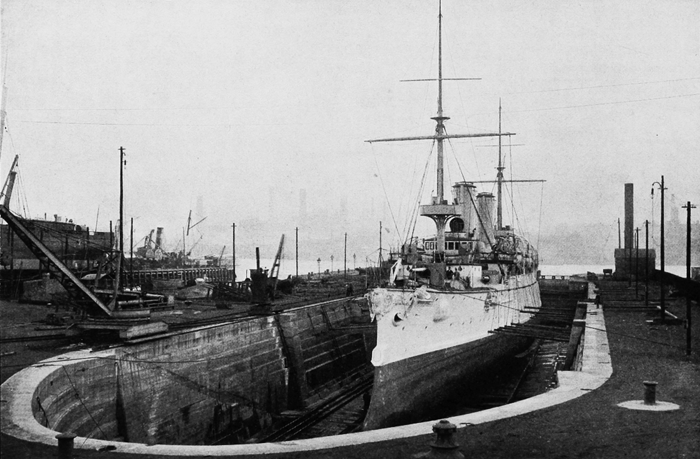
The cruiser in drydock, Cassier’s coll. 1897-1904 CC
Buenos Aires was powered by two 4-cylinder triple-expansion steam engines (VTE), fed by eight horizontal return tube boilers. These were driving two propeller shafts for a total output of 12,500 indicated horsepower (9,300 kW) in natural draught. However she was planned for 17,000 indicated horsepower (13,000 kW) at forced draught but only reached 14,000 indicated horsepower (10,000 kW) under natural draught in trials. Anyway, her top speed of 24 knots reported in some sources was excellent for the time.
As for the range, she carried 1,000 tonnes in normal conditions, for an endurance of 6210 nautical miles at 10 knots.
Armament
Main
Buenos Aires had as main armament two Amstrong Elswick Type S 8 inch (203 mm)/45 calibre guns. The caliber was longer compared to Blanco Encalada resiluting in better range and muzzle velocity. They were mounted fore and aft behind shields on the centreline. Performances:
They fired either 210 pounds (95 kg) AP (Armor Piercing) or 250 pounds (113 kg) HE shells (High Explosive)
Muzzle Velocity velocity 2,650 feet per second (810 m/s) for the AP or 2,480 feet per second (760 m/s) for the HE
Rate of fire was four rounds per minute.
Secondary
Secondary armament was a dual battery: Four Amstrong Elswick Type BB 6 inch (152 mm)/45 calibre gun installed on the four corners under masks, and six Amstrong Elswick Type Y 4.7 inch (120 mm)/45 cal. SF guns also under masks and along the hull. This compared well to the ten 6 inch/40 of the Blanco Encalada as if the caliber was smaller, more rounds were fired at the dame time.
-The 6-in/45 fired 100 pounds (45 kg) at a rate of 7 rounds per minute
-The 4.7-in/45 fired 45 pounds (20 kg) shells at 10 rounds per minute.
Tertiary
The Tertiary armament comprised sixteen 3-pounder Hotchkiss (47 mm) guns. Specs were the same as virtually all models mounted on both the Chilean and Argentinian ships. They were spread between the bridge and aft platform, and the battery deck, with two in poop and two in forward casemates.
It was completed by six Vickers QF 1-pounder pom-pom (20 mm) autocannons mounted on the fighting tops (presumably one of two for each level).
This was completed Five 18-inch (450 mm) Whitehead torpedo tubes: On in the box, four in the broadsides.
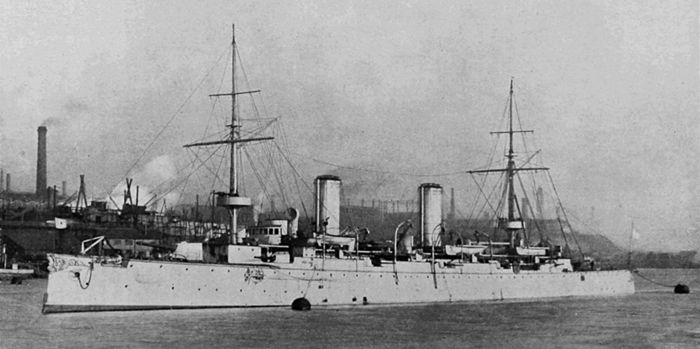
ARA Buenos Aires in 1896 – Cassier’s coll. 1897-1904
⚙ specifications |
|
| Displacement | 4,788 long tons (4,865 t) |
| Dimensions | 396/424 x 46 ft 6 in x 17 ft 4 in ft (121/129 oa x 14.17 x 5.28 m) |
| Propulsion | 2 shafts VTE, 8 cylindrical boilers 17,000 shp |
| Speed | 24 kn (27 mph; 45 km/h) |
| Range | 1000 tonns coal, 6210 nm/10 kts |
| Armament | 2× 8-in/45, 4× 6-in/45 QF, 6× 4.7-in/45 QF, 16× 6-pdr, 6× QF 1-pdr pom-pom, 5 TTs |
| Protection | Deck:5–1+1⁄2 in, Gunshields:4+1⁄2 in, CT 6 in (152 mm) |
| Crew | 400 |
General assessment
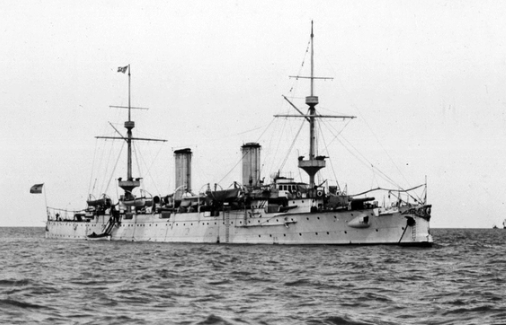
As the last two protected cruisers built before, she was a matter of pride, as the arms race motivated the Amstrong Withworth Elswick yard to improve on the design of previous cruisers each time, leading to some record. The Chilean Esmeralda was at her time the “most powerful cruiser afloat” before the RN obtained the Powerful class, but the latter were armored cruisers. The Argentinian answered in due time to the Esmeralda and Blanco Encalada with an ever better ship, also the world’s fastest. The yard’s chief designer was probably quite happy with the high international tension of the time (between China and Japan, the US and Spain, France and Britain, France and Germany over colonial matters, and of course, Chile and Argentina). This was the third time the Yard built a cruiser as a private venture, which tells a lot about its finances as well. No doubt the pacts of May 1902 ended these “happy times” for the world’s largest shipyard.
After arriving in Argentina, ARA Buenos Aires joined the 1st Division. She settled into a routine of naval exercises interspersed with survey ship duties, especially in the contested waters. The arms race was terminated before she could even fire a short in anger. In 1906, she had a refit in Britain, of which details are not all clear. By 1911 she took part in George V’s coronation Spithead Fleet review. 16 yeare later in 1926, she carried the Spanish Air Force crew (Major Ramón Franco, and copilot/navigator Captain Julio Ruiz de Alda Miqueleiz) from Argentina to a hero′s welcome in Spain after their historic crossing. Between 22 January and 10 February 1926 they just made indeed a record-breaking seven-stop and 6,300-mile (10,145-kilometer) flight under 51 hours from Spain to Buenos Aires.
This was in a Dornier Do J Wal flying boat Plus Ultra nicknamed “Farther Still”. This was perhaps the high point of a rather dull but useful career.
ARA Buenos Aires was stricken on 17 May 1932, sold for BU in 1935. This was overall a cushy and uneventful career for a cruiser that was never given the chance to fight. A practical war between Chile and Argentina would have been the occasion for the Armstrong yard to see its own cruisers fighting on opposite sides with crews largely trained under the RN doctrine.
Buenos Aires was the last Argentinian protected cruiser, as after the Chileans answered with the second Esmeralda and Ministro Zenteno in 1895, the bar was raised further and the four Garibaldi class armoured cruisers were ordered. They arrived by waves between 1895, 96, 97 and 98.
Chile however had a hard time competing and consented to the sole O’Higgins (AC) before estimating it was more efficient to swap directly to fast light battleships and ordered the Constitución (BB)
Libertad (BB) and later its own last protected cruiser, Chacabuco. After the pacts of may, this left the Argentinian Navy in a clear state of superiority.
The Cushy Career of Buenos Aires
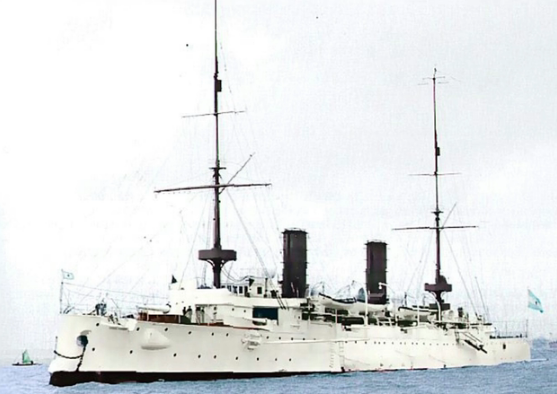
After launched on May 10, 1895, christened by the wife of Commodore D. Martín Rivadavia in UK, which also becale the first commander of the ship, the latter also stayed to monitor the construction of the just purchased Garibaldi class armored cruisers. Commodore Rivadavia became inspector of that construction while command of the Buenos Aires was assigned to his former second in command Commander D. Edelmiro Correa.
She left Britain by mid-March 1896 for her namesake city, arriving at Rada La Plata on April 29, 1896. She sailed to Río Santiago for two months of extra sea trials and training. In June 1896 she joined the 1st Division (main sea squadron) relocated to Golfo Nuevo, for gunnery and torpedo trials. In July, she went for her first official voyage, stopping in Rio de Janeiro, and receiving her war flag embroidered, presented by the Rio de Janeiro ladies, a tradition for the Argentines. Command was passed onto D. Edelmiro Correa. She was back in the Golfo Nuevo by October and patrolled from Puerto Belgrano to Isla Escondida, always with the looming risk of escalation with the Chileans. She spent the bas seaons in La Plata or La Rada.
By 1897 she took part in annual maneuvers alternated with hydrographic studies before building lighthouses in Chubut and Santa Cruz river’s mouth. In August she was back to Bahía Blanca and training with the rest of the division with her sister 9 de Julio, 25 de Mayo, the TB Espora and the coaler Pampa.
In 1898 the same routine repeated, with squadron maneuvers, cut by a naval review at Punta Piedras on October 9. She was back to the Bahía Blanca Division in November and cruised down to Cape Horn. She changed command for Eduardo O’Connor and later D. Juan A. Martín that year and in 1899 where she returned to Rio de Janeiro in August as a goodwil visit with the President of the Republic aboard. She stopped to Santa Cruz and resumed hydrographic survey work in the Chubut river.
In 1900 still in hydrographic tasks in the southern peninsula, for future lighthouses in Chubut and Isla Penguin she was eventually relieved by AEA Santa Cruz and changed command for D. Juan P. Sáenz Valiente. By September whe was in manoeuvers with the two other crusisers and returned to hydrographic tasks.
In 1901 she took part in yearly maneuvers in Bahía Blanca and headed for Puerto Belgrano with President, General D. Julio A. Roca aboard at an average 21 kts to Buenos Aires to rest rapid reaction. In August, Captain D. Félix Dufourg took command and in 1902, D. Alfredo Malbrán, then D. Reinaldo Durand in reduced commission, and back to D. Juan Sáenz Valiente. After her maneuvers in February-May at Puerto Belgrano and Río de la Plata she ended with a reduced crew at NS Río Santiago.
In 1903 she joined the newly created Instruction Division in January, as flagship, with the 25 de Mayo, 9 de Julio and Patagonia in support, commanded by Captain D. Hipólito Oliva and later Vicente E. Montes, training in the Río de la Plata.
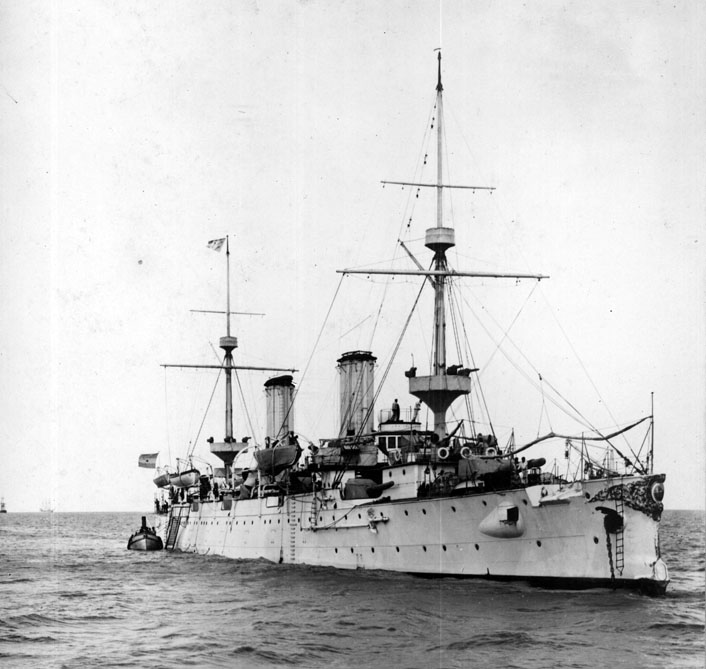
By 1904 until April under Daniel Rojas Torres and José Mascarello she was in reduced commission in station in Río Santiago, most of the time spent in a refit and maintenance. She took part in a presidential review with other cruisers and the new torpedo boats on October 9. The next year she was again in reduced commission under Lt. Mascarello and Antonio L. Mathe, then Gregorio Aguerriberry in the Río de la Plata Naval station. In 1906 D. José Quiroga Furque takes command and she departs for Europe, having a barrel change in Britain. While back she stopped in Brazil and arrived at Buenos Aires on August 15, returning to the Instruction Division in 1907.
Thay year under Guillermo Scott she made her gunnery trials in the Training Division with the ARA San Martín and the Belgrano. By 1908 under Julián Irizar and Diego García she returned to her old squadron with 9 de Julio and 25 de Mayo, Patria and Pampa, Azopardo, training far south, and touring Patagonian ports, practicing landing parties. The Divisi was later dispersed. The cruiser was assigned to the cadet School.
In 1909 under Captain Irizar and Juan I. Peffabet, then Enrique Laborde she took part in April maneuvers in the Gulf of San Matías and San José, practiced a mock attack on Bahía Blanca and entered a shooting and coal loading contests, then a naval review off Puerto Belgrano, then she went back in reduced commission in Rio Santiago under Ismael Galíndez.
In 1910 she only was at sea for 20 days but took part in the yearly naval manoeuvers and she brought President José Figueroa Alcorta to San Antonio Oeste. With ARA Patria she carried president Roque Sáenz Peña to Brazil deployed to Brazil in July and by November was in Rio de Janeiro, carrying back the former Ambassador Dr. Manuel Montes de Oca, but toured Ushuaia with the President for an “icy cruise”.
In 1911 she resumed her voyage to the Tierra del Fuego, then San Antonio Oeste. Later she was under command of Enrique Fliess for another cruise to Ushuaia and a refit at Río Santiago for a long trip abroad, to the occasion of the Coronation of George V at Spithead. While back, she was at the Uruguayan national holidays in Montevideo. After a refit and modernization, notably a new fire control system, she made a trip to Montevideo, Rio de Janeiro, and returned to the 2nd Training Division as flagship in the Río de la Plata. She carried again the President and Minister of Agriculture.
1913 saw her under command of Mariano Beascoechea taking part in the centenary of San Lorenzo Battle, to Rosario and Montevideo. Letr she brought to southern warers Comodoro Rivadavia to the Minister of Agriculture and stopped at Rio de Janeiro for Brazilian national holidays. When WWI began, she was semi-decommissioned, under command of Lt. Beascoechea. She made a cruise to Montevideo and Rio de Janeiro for their national holidays, then Chubut, and and to Comodoro Rivadavia before returning to Río Santiago.
1915 under Regino de la Sota and Ricardo Hermelo only comprised a cruise with cadets to Montevideo as part of the Instruction Division.
In 1916 she stayed at Puerto Belgrano and changed of captain, to Ricardo Camino. When a workers strike broke out in the south, she was sent to Río Gallegos to land there a battalion of the Argentine Army from Azul to put it down.
In 1917 she was placed at reduced crew at Rio Santiago, staying under limited service under Captain Camino as well as for 1918, udner Julio Mendeville. In 1919 under A. Nieva and Félix Tiscornia the situation went on and by 1920, Mariano Beascoechea, then Carlos Braida, still in reduced commission, with maintenance. is concentrated on the maintenance as well as for 1921 under E. L. Previgliano, Luis Merlo, Justino Riobo.
In 1922 she amde two trips to to Rio de Janeiro with gunnery drills under José Gugliotti, and Domingo Castro, Gonzalo Bustamante, Horacio Esquivel, Pedro Gully and Manuel Cavallero from 1923. She stayed in Puerto Belgrano Naval Base as part of the special training programs but sortied for the Brazilian national holidays. The next year under José Guisasola she took part in manoeuvers and gunnery drills, and went to Comodoro Rivadavia and Patagonia ports with the Minister of Public Works aboard, stopping also at Madryn and San Antonio with the Industrial and Commerce Commission of the Chamber of Deputies, followed by naval review in July at Mar del Plata under Américo Fincati before returning to the Training Division in full commission.
In 1925 she remained in the Bahía Blanca area but escorted HMS Repulse a the C-class cruiser HMS Culew during the official visit of the Prince of Wales, followed by her usual trip to Rio de Janeiro for the national holidays. She won the annual artillery award that year under José Gregores and remained in the Instruction Division.
1926 saw her trip to spain with aviators (see above). There she took part in the Inauguration of the Alfonso XIII Canal by Alfonso XIII, going from Seville to Cádiz and Cartagena and flying the old Armada Royal banner, first Argentinian ship to do it. Later back she stopprf and Tenerife and Bahía, then Montevideo and Rio and then La Plata, Madryn, Deseado, Comodoro Rivadavia, and back to Mar del Plata for Xmas.
1927 was quieter. She had a refit at Rio Santiago (but no modernization). She went to Montevideo, Puerto Belgrano for gunnery drills, Rio and back under Francisco Bengolea and Guillermo Ceppi.
The next year she entered the “Scout Division” with the destroyers Cervantes, Garay, Catamarca and Córdoba as a squadron through the Río de la Plata under Jorge Games. She also made her usual triped to Rio and Montevideo with President Hipólito Irigoyen. In 1929 she was under Virgilio Patalano and Arturo Monkes, making a trip to Cuba, representing the country with ministers and Admiral D. Juan A. Martín onboard. Back in June shewent into reduced commission Rio Santiago. In 1930 under Tulio Guzmán. In May, Virgilio Patalano, Eleazar Videla, she saw her schedule broken by the “revolution of September” and she headed for Río Santiago under semi-commission under Ricardo López Campo, Juan E. Cánepa, José M. Gugliotti and in 1931 Juan Bonomi, then Gugliotti again. She became flagship of the Naval Training Force, making short cruises in La Plata. By 1932 under Juan González, Abelardo Pantin she reproduced the same routine as for 1933 and 1934, then full decommission that year. She was stricken and sold in 1935 for scrapping.
Read More
Books
Brassey, T.A. (1897). The Naval Annual 1897. Portsmouth, UK: Griffin and Co.
Brooke, Peter (1999). Warships for Export: Armstrong Warships 1867–1927. World Ship Society.
“Firing Trials of Elswick Cruiser Buenos Aires” (PDF). The Engineer. Vol. 80. 13 December 1895.
Chesneau, Roger; Kolesnik, Eugene M (1979). Conway’s All the World’s Fighting Ships 1860–1905.
Bóveda, Jorge Rafael 2009-2010 «García-Mansilla, un marino de fin de siglo». «Las maniobras Navales de 1902. La evolución de las tácticas de la Armada Argentina ante el conflicto con Chile, 1881-1902». Boletín del Centro naval.
Salas, Nicolás (1993). Sevilla: crónicas del siglo XX. Volumen 3. Sevilla: Universidad de Sevilla.
Memories of Marina; oo. G.G.; oo. DD.; circulars; A.G.M.: years 1895/1931.
“The artillery of ARA Buenos Aires”. Peffabet, in B. C. N. Vol. 13; “The cruiser Buenos Aires”. Anonymous
“Memories of the cruiser Buenos Aires” by Caillet Bois, Theodore. B.C.N. Vol. 54
“The exercise of the function of responsibility in the command: Cruiser Buenos Aire» 1899/1900”. Almirante Martín, Juan A.
“The novel of the sea”. Rear Admiral Beascoechea, 1929.
Rear Admiral D. Mariano F. Beascoechea memories.
“Speed Trials of the New Argentine Cruiser — Buenos Aires” (PDF). The Engineer.
“The Argentine Cruiser Buenos Aires” (PDF). The Engineer. Vol. 82. 31 July 1896. pp. 106, 114.
Links
histarmar.com.ar
en.wikipedia.org/
navypedia.org/
Model Kits

Ocean moon 1:700 kit, the only known. Detail of the kit.


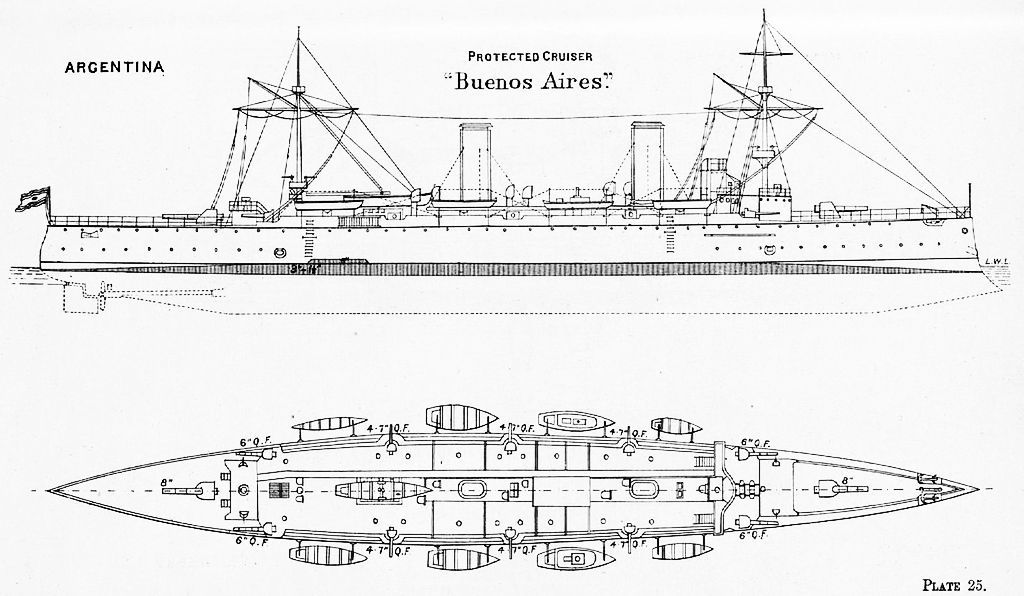
 Latest Facebook Entry -
Latest Facebook Entry -  X(Tweeter) Naval Encyclopedia's deck archive
X(Tweeter) Naval Encyclopedia's deck archive Instagram (@navalencyc)
Instagram (@navalencyc)





 French Navy
French Navy Royal Navy
Royal Navy Russian Navy
Russian Navy Armada Espanola
Armada Espanola Austrian Navy
Austrian Navy K.u.K. Kriegsmarine
K.u.K. Kriegsmarine Dansk Marine
Dansk Marine Nautiko Hellenon
Nautiko Hellenon Koninklije Marine 1870
Koninklije Marine 1870 Marinha do Brasil
Marinha do Brasil Osmanlı Donanması
Osmanlı Donanması Marina Do Peru
Marina Do Peru Marinha do Portugal
Marinha do Portugal Regia Marina 1870
Regia Marina 1870 Nihhon Kaigun 1870
Nihhon Kaigun 1870 Preußische Marine 1870
Preußische Marine 1870 Russkiy Flot 1870
Russkiy Flot 1870 Svenska marinen
Svenska marinen Søværnet
Søværnet Union Navy
Union Navy Confederate Navy
Confederate Navy Armada de Argentina
Armada de Argentina Imperial Chinese Navy
Imperial Chinese Navy Marinha do Portugal
Marinha do Portugal Mexico
Mexico Kaiserliche Marine
Kaiserliche Marine 1898 US Navy
1898 US Navy Sovietskiy Flot
Sovietskiy Flot Royal Canadian Navy
Royal Canadian Navy Royal Australian Navy
Royal Australian Navy RNZN Fleet
RNZN Fleet Chinese Navy 1937
Chinese Navy 1937 Kriegsmarine
Kriegsmarine Chilean Navy
Chilean Navy Danish Navy
Danish Navy Finnish Navy
Finnish Navy Hellenic Navy
Hellenic Navy Polish Navy
Polish Navy Romanian Navy
Romanian Navy Turkish Navy
Turkish Navy Royal Yugoslav Navy
Royal Yugoslav Navy Royal Thai Navy
Royal Thai Navy Minor Navies
Minor Navies Albania
Albania Austria
Austria Belgium
Belgium Columbia
Columbia Costa Rica
Costa Rica Cuba
Cuba Czechoslovakia
Czechoslovakia Dominican Republic
Dominican Republic Haiti
Haiti Hungary
Hungary Honduras
Honduras Estonia
Estonia Iceland
Iceland Eire
Eire Equador
Equador Iran
Iran Iraq
Iraq Latvia
Latvia Liberia
Liberia Lithuania
Lithuania Mandchukuo
Mandchukuo Morocco
Morocco Nicaragua
Nicaragua Persia
Persia San Salvador
San Salvador Sarawak
Sarawak Uruguay
Uruguay Venezuela
Venezuela Zanzibar
Zanzibar Warsaw Pact Navies
Warsaw Pact Navies Bulgaria
Bulgaria Hungary
Hungary

 Bundesmarine
Bundesmarine Dutch Navy
Dutch Navy Hellenic Navy
Hellenic Navy Marina Militare
Marina Militare Yugoslav Navy
Yugoslav Navy Chinese Navy
Chinese Navy Indian Navy
Indian Navy Indonesian Navy
Indonesian Navy JMSDF
JMSDF North Korean Navy
North Korean Navy Pakistani Navy
Pakistani Navy Philippines Navy
Philippines Navy ROKN
ROKN Rep. of Singapore Navy
Rep. of Singapore Navy Taiwanese Navy
Taiwanese Navy IDF Navy
IDF Navy Saudi Navy
Saudi Navy Royal New Zealand Navy
Royal New Zealand Navy Egyptian Navy
Egyptian Navy South African Navy
South African Navy






























 Ukrainian Navy
Ukrainian Navy dbodesign
dbodesign